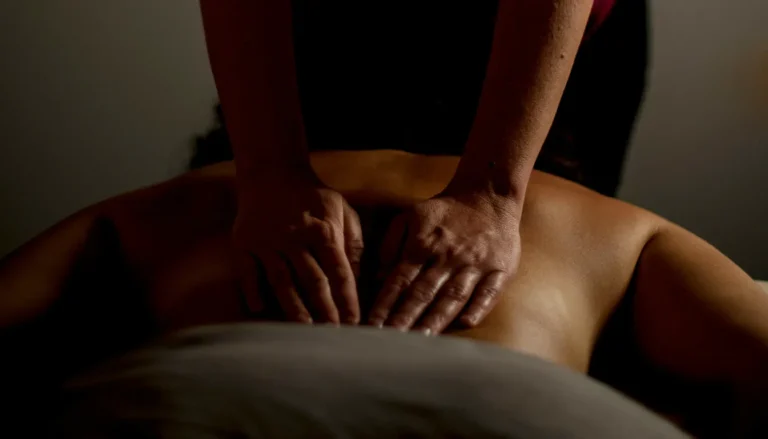This practical UK guide explains the mechanisms that make a shoulder massage an effective route to relief.
Targeting the upper trapezius, rhomboids and rotator cuff, a focused treatment uses kneading, effleurage and acupressure to warm tissue and boost capillarisation. That increase in circulation brings oxygen and nutrients to tired muscles and aids lymphatic drainage, which clears metabolic waste.
Physiological shifts matter: hormone changes can lift serotonin and dopamine while lowering cortisol, helping the mind to feel calmer. Working trigger points briefly reduces blood flow, and release then invites reactive hyperaemia — fresh blood that soothes pain and eases tension.
In everyday terms, regular sessions can reduce soreness, improve posture and restore range of movement. The article that follows will show simple techniques, UK-friendly posture tips for desk work, device-assisted options and safety pointers for home practice.
Key Takeaways
- Targets key muscles to raise temperature and improve circulation.
- Techniques range from gentle strokes to focused pressure for different needs.
- Physiological effects include better lymphatic flow and helpful hormone changes.
- Regular, safe practice can ease tension, aid sleep and support long‑term health.
- Clear sequences and posture advice make home routines practical in the UK.
Understanding how is stress relieved by shoulder massage
Tightness in the neck-shoulder complex often shows as heavy, restricted movement after long workdays or a minor injury. Gentle, sustained pressure and warming strokes raise muscle temperature, easing guarding and lowering pain signals.
Improved circulation brings fresh blood, oxygen and nutrients to tired muscles. That helps fibres relax and supports lymphatic flow to clear waste products. As muscles such as the trapezius and rhomboids loosen, nearby areas stop overcompensating and general fatigue drops.
Regular, light to moderate work can improve elasticity and range of motion, which helps posture over time. Hormonal shifts—more serotonin and dopamine, less cortisol—add a calming effect that explains why people feel settled after a session.
- Neck and shoulder tightness often limits movement and adds pain.
- Warming tissue and steady pressure reduce guarding and soothe nerves.
- Targeted work on key muscles reduces overuse elsewhere and aids recovery.
- Short-term relief is common; lasting change needs routine and better daily habits.
| Benefit | Primary muscles | Typical effect |
|---|---|---|
| Reduced pain | Upper trapezius | Less guarding, improved motion |
| Better circulation | Rhomboids | More oxygen, faster recovery |
| Improved posture | Rotator cuff and neck muscles | Less overcompensation, less fatigue |
| Calm feeling | Local and systemic | Hormonal shift, reduced nervous arousal |
The science behind relaxation: blood flow, hormones and muscle tension
A brief rise in tissue temperature starts a chain of vascular and nervous changes that ease tight fibres. Warming the area raises capillarisation and encourages vasodilation, so local blood moves more freely and nutrients arrive where they are needed.
Improved circulation: raising muscle temperature to ease tight muscles
Effleurage and kneading increase local circulation and boost lymphatic return. This improves waste clearance and helps knots soften. When muscle temperature rises, fibres lengthen more easily and release without force.
Hormonal shift: boosting serotonin and dopamine while lowering cortisol
Gentle work prompts a chemical change. Levels of serotonin and dopamine tend to rise while cortisol falls, supporting calmness and deeper relaxation across the neck shoulder region.
Pain gating and pressure: how gentle pressure calms the nervous system
Focused pressure can trigger a short ischaemic response. On release, reactive hyperaemia floods the spot with blood and oxygen, which helps soften stubborn knots. At the same time, touch receptors interrupt nociceptive signals — a pain‑gating effect that reduces perceived pain and eases overall tension.
“Slow circular motions favour a parasympathetic response, encouraging true relaxation of both muscle and mind.”
- Warming increases extensibility and safer stretching.
- Capillary changes improve nutrient delivery and waste removal.
- Ischaemic–hyperaemic cycles treat persistent knots in the upper trapezius.
How to give yourself a shoulder massage at home
A simple, peaceful setup at home makes short sessions feel restorative and easy to keep up. Create a spa-like corner with dim lighting, calm music and two or three deep breaths to cue the nervous system into relaxation.
Set the scene: a calm UK home setup for stress relief
Choose a comfortable chair and a small towel for support. Soft music and low lights help the body and mind unwind before you start.
Warm-up moves: shoulder rolls and light effleurage to start
Begin with slow shoulder rolls for 20–30 seconds. Then use flattened hands to glide over the upper back and tops of the shoulders, warming tissue and encouraging blood flow.
Main sequence: circular motions, kneading and thumb work on the upper back
Work in short bursts. Use fingertips and thumbs to apply gentle pressure to tender spots. Move in circular motions for 10–20 seconds, then switch to broad kneading strokes with your hands to mobilise tissue and support smooth flow.
Cool-down: soothing strokes to encourage relaxation and better sleep
Finish with long, slow strokes from the neck shoulder junction outward to the deltoid. Keep the body relaxed and breathe steadily. Aim for 5–15 minutes depending on time; tennis balls or a foam roller can add targeted pressure if needed.
- Tip: Use gentle pressure and stop if you feel sharp pain.
- Alternate kneading and broad strokes to balance warmth and release.
Core shoulder massage techniques explained
This section walks through five practical techniques to ease tight upper‑back muscles and restore softer movement. Each method has a clear role: warming, releasing knots, or encouraging lymphatic flow.
Acupressure on knots and trigger points with fingertips and thumbs
Acupressure uses steady pressure from a thumb or fingertip on a tender knot for 10–30 seconds, then a slow release. Temporary ischaemia softens the knot and, on release, increased blood brings repair nutrients and reduces local pain.
Kneading to improve elasticity and reduce soreness
Use flat hands or relaxed fists to rhythmically squeeze and lift soft tissue. This raises muscle temperature and improves elasticity, which eases soreness and helps muscles work better.
Effleurage for relaxation and enhanced lymphatic flow
Long, flattened‑hand strokes act as a reset between deeper work. Vary pressure gently to encourage calm and support lymphatic flow that removes waste from the area.
Skin rolling to free tight tissues and aid circulation
Lift small folds of skin and roll them between fingers and thumbs. This loosens adhered fascia and improves local circulation without heavy pressure.
Trigger pointing for focused relief in the neck‑shoulder area
Target mid‑fibre hotspots in the upper trapezius and rhomboids with focused pressure. Hold briefly, then ease off to invite reactive blood flow and repair for the muscle.
- Start light and build pressure slowly; stop if pain radiates.
- Combine techniques: effleurage to warm, kneading for elasticity, acupressure for stubborn knots, then soothing strokes to finish.
- Improved circulation supports nutrient delivery and reduces recurring tightness.
| Technique | Main effect | Best used for |
|---|---|---|
| Acupressure | Local ischaemia then reactive blood flow | Small knots and trigger points |
| Kneading | Raises temperature, boosts elasticity | General muscle soreness and stiffness |
| Effleurage | Soothes and aids lymphatic flow | Warm up and cool down strokes |
| Skin rolling | Frees adhered tissue, improves circulation | Sticky fascia and surface tension |
For guided routines and professional guidance on a proper shoulder massage, consult a qualified therapist—especially if pain persists. Gentle, regular practice brings steady relief and better function to the muscles in daily life.
Device-assisted relief: heat, kneading and smart settings
Electric massagers bring steady kneading, vibration and warmth to tight upper-back muscles without needing a second person. These units mimic hand motions with rotating nodes, offer bidirectional kneading and have simple controls for speed and heat.
When to pick a device over hands-on therapy
- Choose a device for consistent pressure and deep kneading that you cannot sustain manually.
- They work well if you want regular sessions at home, or to add heat to pre‑treatment warm‑up.
Heat plus kneading: enhancing blood flow and tension release
Heat settings (typically 38–45 °C) warm tissue and support improved circulation. Combined with kneading, this speeds softening of tight fibres and eases local pain.
Best practice: session length, positioning and gentle pressure
Sit in a high‑back chair with the device snug over the upper trapezius. Keep your chin level and breathe slowly.
Start on a low speed and add mild strap pressure only if comfortable. Limit sessions to 15–20 minutes to avoid soreness. Frequency: 2–3 times weekly for mild tension, daily for chronic tightness if tolerated.
“Use heat first to warm tissue, then switch to kneading-only if you feel too warm.”
| Feature | Typical setting | Benefit |
|---|---|---|
| Kneading nodes | Low–medium speed | Deep, repeatable pressure for tight fibres |
| Heat | 38–45 °C | Improves blood flow and tissue extensibility |
| Vibration | Optional | Surface relaxation and comfort |
| Session length | 15–20 minutes | Effective without overworking tissue |
Quality experience tips: track your response after each session. If pain, pins or tingling arise, stop and reassess position or settings. Combine device use with light stretches and slow breathing for a balanced relaxation routine that protects the body and supports lasting relief.
Posture, daily habits and simple exercises to keep shoulders calm
Small changes to posture and short daily drills make a big difference to neck and upper back comfort. These habits protect muscles and help any treatment feel more effective.
Better posture at your desk: small tweaks, big relief
Set your screen at eye level, keep elbows near 90° and feet flat. This reduces forward head carriage and eases neck shoulder loading.
Take movement breaks every 30–60 minutes. Stand, roll the shoulders and open the chest for 30 seconds to interrupt poor posture and tired muscles.
Mini mobility routine: traps, rotator cuff and upper back
Try a short sequence: scapular retractions, gentle upper back extensions over the chair and slow neck side bends. Repeat each move 6–10 times.
Add light band work for the rotator cuff to support stability. These simple exercises build resilience and cut recurrence of tension.
- Use gentle manual work between work blocks to warm tissue and make posture correction feel natural.
- Notice early signs of tightness and respond with two minutes of deep breathing plus targeted moves.
- Keep shoulders relaxed while typing; avoid craning the head forward so the body stays balanced.
| Action | Benefit |
|---|---|
| Screen at eye level | Less neck strain, better posture |
| Micro-breaks every 30–60 mins | Reduced poor posture and quicker recovery |
| Mini mobility routine | Improved range and muscle flexibility |
Aim for small daily changes. Over weeks those habits add up to lasting relief and better long‑term health of the neck, upper back and shoulder muscles.
Safety, pressure guidelines and when to seek professional therapy
Safe practice begins with light contact and steady monitoring of your body’s cues. Use gentle pressure first and only increase if the area feels comfortable.
How much pressure is safe around the neck and shoulders
Use light to moderate pressure across the neck and upper back. Aim for a 5–6/10 comfort range; this avoids aggravation and supports steady progress.
Apply work with the pads of your fingers or fingertips, not pokey joints. Avoid pressing the front of the neck or hard bony landmarks.
Trigger point holds should feel tolerable, never sharp or radiating. Keep focused holds to 10–30 seconds, then follow with broader strokes to restore circulation.
Red flags: pain, numbness or dizziness that need expert help
Stop immediately if you experience spreading pain, numbness, pins and needles, dizziness, unusual weakness or severe headache. These signs need clinical assessment.
- Begin with gentle pressure and increase slowly; stay within a comfortable 5–6/10 range.
- Use fingertips and pads of the fingers rather than hard tips or nails.
- Limit focused holds to short durations, then return to sweeping strokes.
- If pain discomfort lasts beyond 24–48 hours, reduce intensity and seek advice.
- Recent injury, surgery or complex medical conditions require professional therapy before self-work.
| Area | Safe action | Limit |
|---|---|---|
| Neck front | Avoid direct pressure | Do not compress |
| Upper back | Light–moderate pressure with fingertips | 5–6/10 comfort |
| Tender knot | Short hold, slow release | 10–30 seconds |
Device use: follow manufacturer timings and avoid daily overuse to reduce post-session fatigue. For practical guidance on safe self-work, see this short guide to self-care: self-massage tips.
Conclusion
A simple, regular routine that blends warm-up moves, focused work and soothing strokes brings clear benefits for body and mind.
Warming tissue increases circulation and lymphatic flow, softening trigger points while lifting serotonin and dopamine and lowering cortisol for a calmer experience.
Start with gentle preparation, follow with targeted techniques, then finish with long, calming strokes to lock in the effect. Consistent short sessions improve posture, elasticity and reduce recurring soreness.
For deeper, heat-assisted easing you can combine hands-on work with a device. For more tips on neck and upper-back care see this short guide: neck and shoulder relief.
Listen to your body: use comfortable pressure, keep sessions sensible and stop if unusual signs appear. Make this a gentle part of your evening wind-down for better sleep and lasting stress relief.
FAQ
What happens in the body when tension in the upper back is eased?
Gentle work on tight muscles boosts local circulation, raising tissue temperature and delivering oxygen. That helps reduce soreness and can lower blood pressure slightly. Nerve signals for pain quieten, promoting a calmer nervous system and a clearer mood.
Which hormones change during a relaxing session and why does mood improve?
Calm touch encourages release of serotonin and dopamine while reducing cortisol. This hormonal shift supports relaxation, better sleep and a sense of wellbeing after treatment.
Can simple pressure techniques numb or block pain signals?
Yes. Applying steady, gentle pressure to trigger points interrupts pain pathways — a gating effect — so discomfort feels reduced. That makes movement easier and eases muscle guarding.
What should I do to prepare a cosy space at home for therapy?
Create a warm, quiet corner with a chair or sofa and a towel for support. Soft lighting, a hot drink and minimal clutter help. Small changes make self-care feel more effective and inviting.
Which warm-up moves are best before deeper work?
Start with slow shoulder rolls and light effleurage across the upper back. These moves increase blood flow, loosen tissue and make deeper kneading more comfortable.
What main sequence gives steady relief for knots in the trapezius?
Use circular motions to locate tight spots, follow with alternating kneading and focused thumb work, then finish with broad, soothing strokes across the shoulders to settle the area.
How should I finish a self-massage to promote sleep and relaxation?
End with gentle long strokes from neck to shoulder blades and a few slow head tilts. Spend a minute on diaphragmatic breathing to reinforce the relaxation response.
What are the most effective hands-on techniques for stubborn tightness?
Acupressure on trigger points, sustained kneading to soften fibres, effleurage for calming, and skin rolling to free adhesions are highly effective when used together.
When is a device preferable to hands-on work?
Choose a neck-shoulder massager when you need consistent pressure for longer sessions, when hands are tired, or to combine heat and kneading for deeper circulation and faster relief.
How does heat improve the effects of mechanical kneading?
Heat dilates blood vessels and raises muscle temperature, making tissues more pliable. Combined with kneading, it speeds removal of metabolic waste and eases tightness more quickly.
What session length and pressure work best with device-assisted therapies?
Start with 10–20 minutes at low to medium intensity. Maintain comfortable pressure and avoid strong force near the cervical spine. Adjust based on sensation and gradually increase if needed.
Which posture tweaks at a desk give the biggest benefit?
Raise your screen to eye level, keep shoulders relaxed (not hunched), and use a supportive chair. Take short movement breaks every 30–45 minutes to reset muscles.
Are there quick mobility moves for the traps and rotator cuff?
Yes. Gentle band pull-aparts, scapular squeezes and controlled shoulder circles restore range and reduce stiffness. Do a few reps throughout the day to prevent build-up.
How much pressure is safe near the neck?
Use light to moderate pressure around the cervical area. Avoid deep compressions over the front of the neck and stop if you feel sharp pain, pins and needles, or dizziness.
Which warning signs mean I should see a therapist or GP?
Seek professional help for persistent pain, numbness, weakness, sudden swelling, loss of balance, or symptoms that spread down an arm. Those can signal nerve compression or other serious issues.





